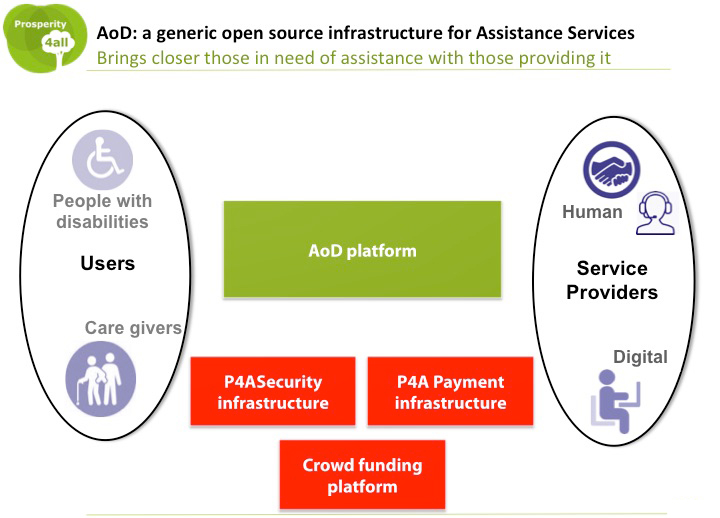
Users / Actors
The users of the Assistance on Demand can be organized in the following groups:
- Service providers / service developers who want to offer services, either human or web based (also called machine based), through the AoD platform.
- Service consumers (end-users) including people with disabilities, older people, employees with different skills and expectations as well as third parties that are interested in using a service.
- Care givers who are interested in setting up a network of services for those that they provide care for (after completing an authorization process).
- Public or private organisation, association or community that decides to use the Assistance on Demand platform and/or open source s/w to create its own AoD instance, towards offering a variety of services. This could be, for instance, an association of people with disabilities in a given country, or a given community offering services to a group of people.
- Administrator is a special user with technical background (probably a system administrator) who is responsible for the installation and maintenance of the platform, as well as the monitoring of the normal operation of the platform.
Supported Functionality
The Assistance on Demand (AoD), once set up and properly configured by an organization or company, offers a set of unique features.
- It allows individuals who seek assistance to search in an organized manner in a set of predefined sources based on the type of need, the type (human or machine based) and quality of the required service, and other personal preferences.
- It allows application developers and service providers to easily register the services that they offer (or set up new ones), which can be of any type e.g. machine, human, crowd-based assistance services, etc. In this way, they can promote and sell their services bringing them closer to large audiences.
- It supports multiple charging models and enables payment for all services through the associated P4All payment system, including the support of micropayment and micro-funding schemes. In this way, the AoD relieves service providers from developing/deploying their own charging/payment infrastructures. This does not exclude the possibility for service providers to use their own payment system, if they wish.
- It enables the offering of multiple services to one (or more users), i.e. it allows an individual in need of care or their carer to define a network of assistance services.
- It supports the set up and offering of multi-modal technical support offered by humans or automatic systems.
- It offers zero/default configuration mode options for efficiently supporting users with low digital literacy in setting up AoD services.
It may include crowd-funding functionality for new services, thus it can help service providers to discover new user needs and undertake the development of new services.
